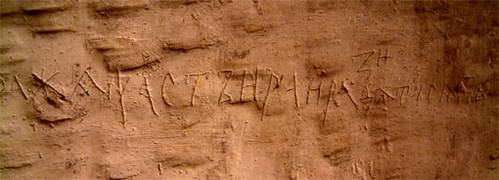There is an unusual 9-10th century cave monastery in Basarabi, Romania. There are pictures and writings carved on the walls of cave and it is multi-lingual with old church slavonic and Turkic words, mostly written in Turkic runic script and few in Glagolitic.
Inscriptions and pictures in the Monastery dated from the era of first Bulgar kingdom, late 9th century and early 10th century. Some inscriptions mentions about Bulgar king Simeon I of 890 AD. So, it`s few decades after Bulgar people started to be converted to christianity. Some scholars says that the inscriptions belongs to Pecheneg(Patzinak) Turks, some says it belongs to Bulgars but it`s not known for sure.
Basarabi Cave Complex
The complex of cave churches situated near the village of Basarabi, in Dobrudja (Romania), not far from Constanta, was discovered in 1957. Until the last third of the tenth century the entire complex consisted probably of a group of limestone quarries which provided various blocks of chalk used in the construction of the upper part of the Great Stone Wall of Dobrudja, from Constanta up to Cernavoda. According to I. Barnea, the extraction of stone could have ended under John Tzimiskes (969-976) or Basil the 2nd (976-1025).
The abandoned caves could have been then transformed into a monastery. It so happened that the complex changed into a group of churches and burial chambers, located inside the limestone hill, at different levels, and interconnected through galleries.
Most of the chamber-walls are covered with overlapping graffiti, including drawings and inscriptions, thus making possible to discern different periods of the site’s history.
The variety of the graffiti is wide: there are Christian symbols, drawings of animals and men, Turkic runes, and Cyrillic inscriptions. These drawings could have appeared as early as mid-tenth century, as supposed by D. Ovcharov. Among the Basarabi graffiti there is a large number of runic inscriptions and separate signs, undoubtedly of Turkic origin.













These are some drawings of christian saints with Turkic runic inscriptions on them in old church slavonic or Turkic words;




There is a video of this cave monastry in this Romanian website;
For more info and pictures;
.
Inscriptions and pictures in the Monastery dated from the era of first Bulgar kingdom, late 9th century and early 10th century. Some inscriptions mentions about Bulgar king Simeon I of 890 AD. So, it`s few decades after Bulgar people started to be converted to christianity. Some scholars says that the inscriptions belongs to Pecheneg(Patzinak) Turks, some says it belongs to Bulgars but it`s not known for sure.
Basarabi Cave Complex
The complex of cave churches situated near the village of Basarabi, in Dobrudja (Romania), not far from Constanta, was discovered in 1957. Until the last third of the tenth century the entire complex consisted probably of a group of limestone quarries which provided various blocks of chalk used in the construction of the upper part of the Great Stone Wall of Dobrudja, from Constanta up to Cernavoda. According to I. Barnea, the extraction of stone could have ended under John Tzimiskes (969-976) or Basil the 2nd (976-1025).
The abandoned caves could have been then transformed into a monastery. It so happened that the complex changed into a group of churches and burial chambers, located inside the limestone hill, at different levels, and interconnected through galleries.
Most of the chamber-walls are covered with overlapping graffiti, including drawings and inscriptions, thus making possible to discern different periods of the site’s history.
The variety of the graffiti is wide: there are Christian symbols, drawings of animals and men, Turkic runes, and Cyrillic inscriptions. These drawings could have appeared as early as mid-tenth century, as supposed by D. Ovcharov. Among the Basarabi graffiti there is a large number of runic inscriptions and separate signs, undoubtedly of Turkic origin.









These are some drawings of christian saints with Turkic runic inscriptions on them in old church slavonic or Turkic words;




There is a video of this cave monastry in this Romanian website;
For more info and pictures;
.
































Comment